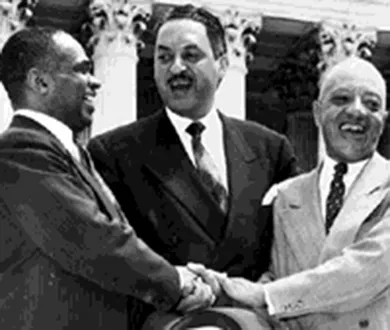As a lawyer and judge, Thurgood Marshall strived to protect the rights of all citizens. His legacy earned him the nickname "Mr. Civil Rights."

Thurgood Marshall was born Thoroughgood Marshall on June 2, 1908 in Baltimore, Maryland. Tired of having his friends poke fun at his first name, he decided to try to improve the situation and, at the age of six, legally changed it to Thurgood. As a young man, perhaps the person who had the most influence on him was his father, a man who always told his son to stand up for his beliefs. His father's influence was so strong that, later in life, Marshall once said that his father "never told me to become a lawyer, he turned me into one."
Early Life
Arguably, Marshall's introduction to law came in high school when, as a punishment for a prank he had pulled, the school's principal made him read the U.S. Constitution. Marshall immediately liked the document and set about memorizing various parts of it. He took special interest in Article III and the Bill of Rights. Article III establishes the judicial branch of government and the Bill of Rights lists the rights that all American citizens are supposed to enjoy. Growing up in an era when Jim Crow laws still permeated much of the country, Marshall knew that many African-Americans were not enjoying all of their constitutional rights. From an early age, Marshall was aware of racial injustices in America, and he decided to do something about them. Moreover, he also knew that the courts might be the best means for doing so.
Education
Marshall attended the all-black Lincoln University (the oldest African-American institution of higher education in the country) and, after being rejected from the University of Maryland School of Law because of his race, went on to attend law school at Howard University and graduated first in his class. It was at Howard University that Marshall met Charles Hamilton Houston, the vice-dean of the law school. In 1935, Houston directed the NAACP Legal Defense and Education Fund, and Marshall was his right-hand man.
It was during this time that Marshall realized that the holding in Plessy was inherently flawed, for "separate" could never be "equal." Marshall had always felt that the only way for African-Americans, or anyone for that matter, to succeed was to receive an education. Yet, the discrepancy in the caliber of education for whites and blacks was made all too apparent to him when, one day while traveling with Houston, Marshall witnessed a black child biting into an orange. He had received such a poor education that he neither knew what it was nor how to properly eat it. From this point on, Marshall and Houston were dedicated to a strategy which aimed at ending segregation.
Legal Career
Together with Houston, Marshall participated in the cases Murray v. Maryland (1936) and Missouri ex rel Gaines v. Canada (1938). When Houston returned to private practice in 1938, Marshall took over the NAACP Legal Defense and Education Fund and argued Sweatt v. Painter (1950) and McLaurin v. Oklahoma Board of Regents of Higher Education (1950). Having won these cases, and thus, establishing precedents for chipping away Jim Crow laws in higher education, Marshall succeeded in having the Supreme Court declare segregated public schools unconstitutional in Brown v. Board of Education (1954).
After Brown, Marshall argued many more court cases in support of civil rights. His zeal for ensuring the rights of all citizens regardless of race caught the attention of President John F. Kennedy, who appointed him to the U.S. Court of Appeals. In 1965, Lyndon Johnson appointed him to the post of Solicitor General (this person argues cases on behalf of the U.S. government before the Supreme Court; it is the third highest office in the Justice Department). Finally, in 1967, President Johnson appointed him to the U.S. Supreme Court. Until his retirement from the Court in 1991, Marshall continued to strive to protect the rights of all citizens. Thurgood Marshall died in 1993, leaving behind a legacy that earned him the nickname "Mr. Civil Rights." Before his funeral, his flag-draped casket was laid in state in the Great Hall of the Supreme Court. He was only the second justice to be given this honor.
Moments in History
Justice Thurgood Marshall was one of the country's greatest jurists and civil rights advocates, but he was also a gifted storyteller who liked to leaven even a serious tale with a sprinkling of humor.
